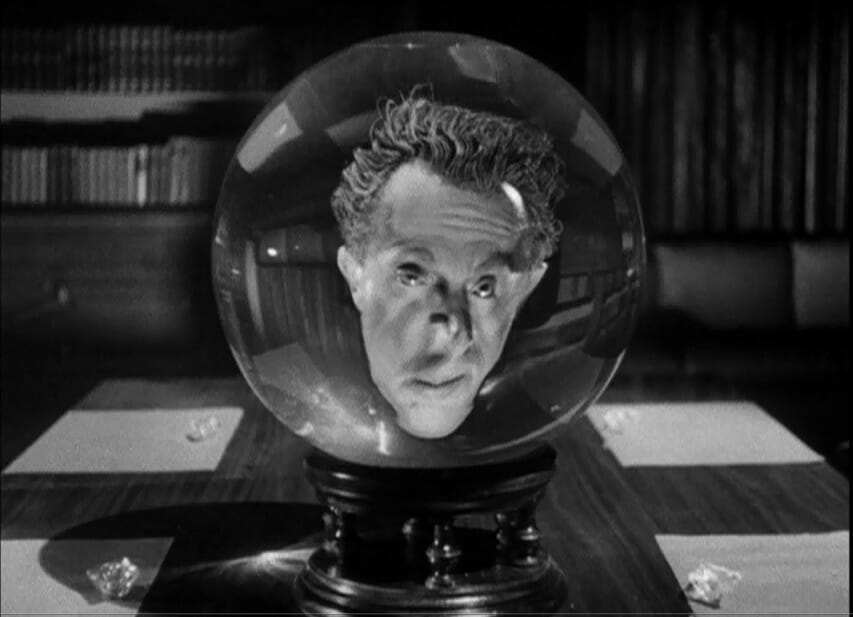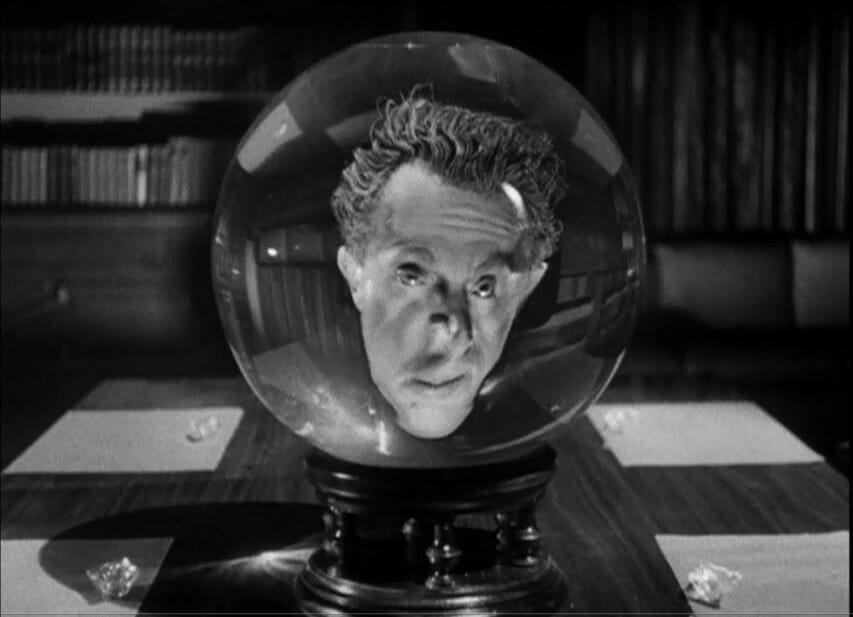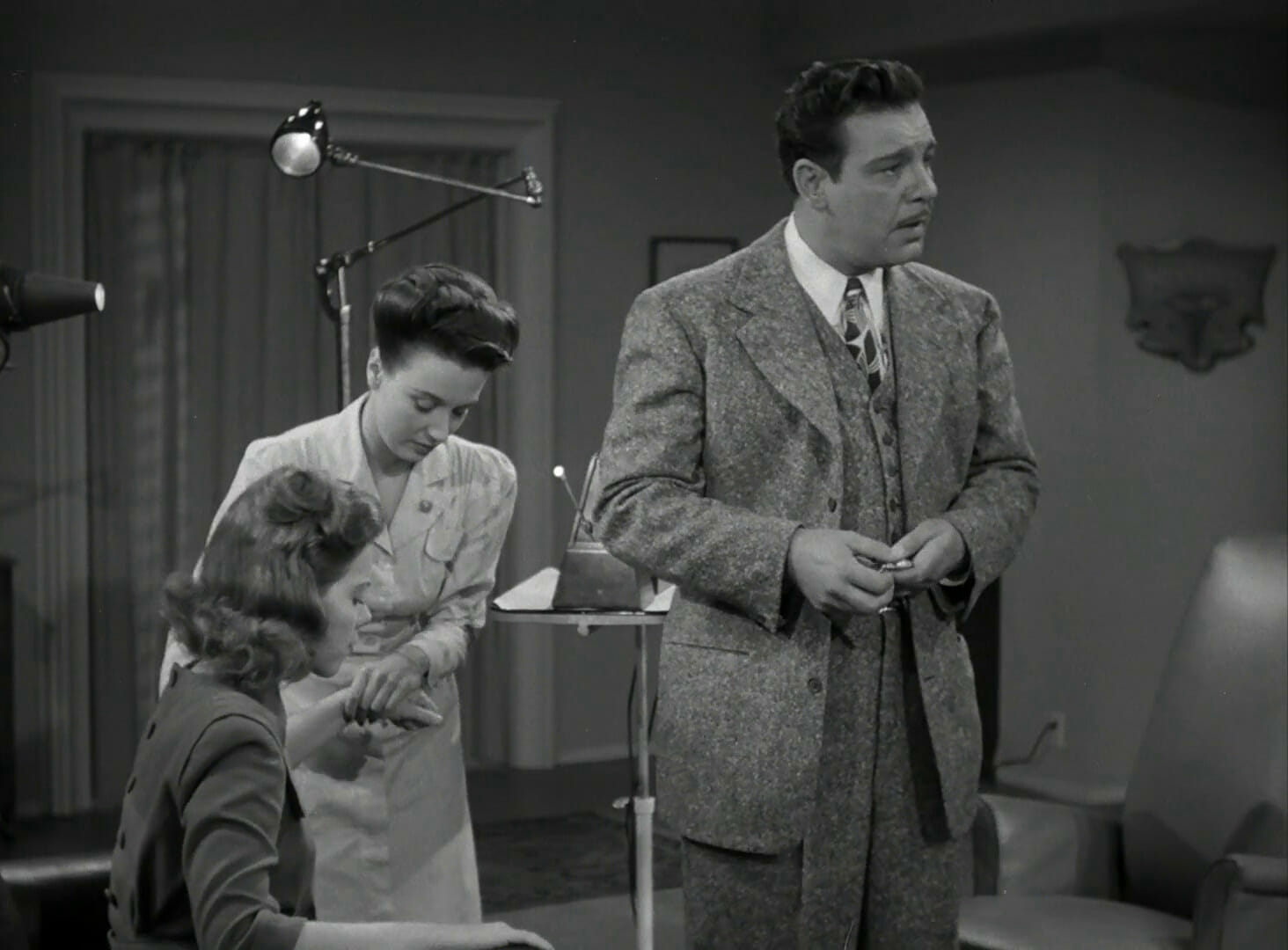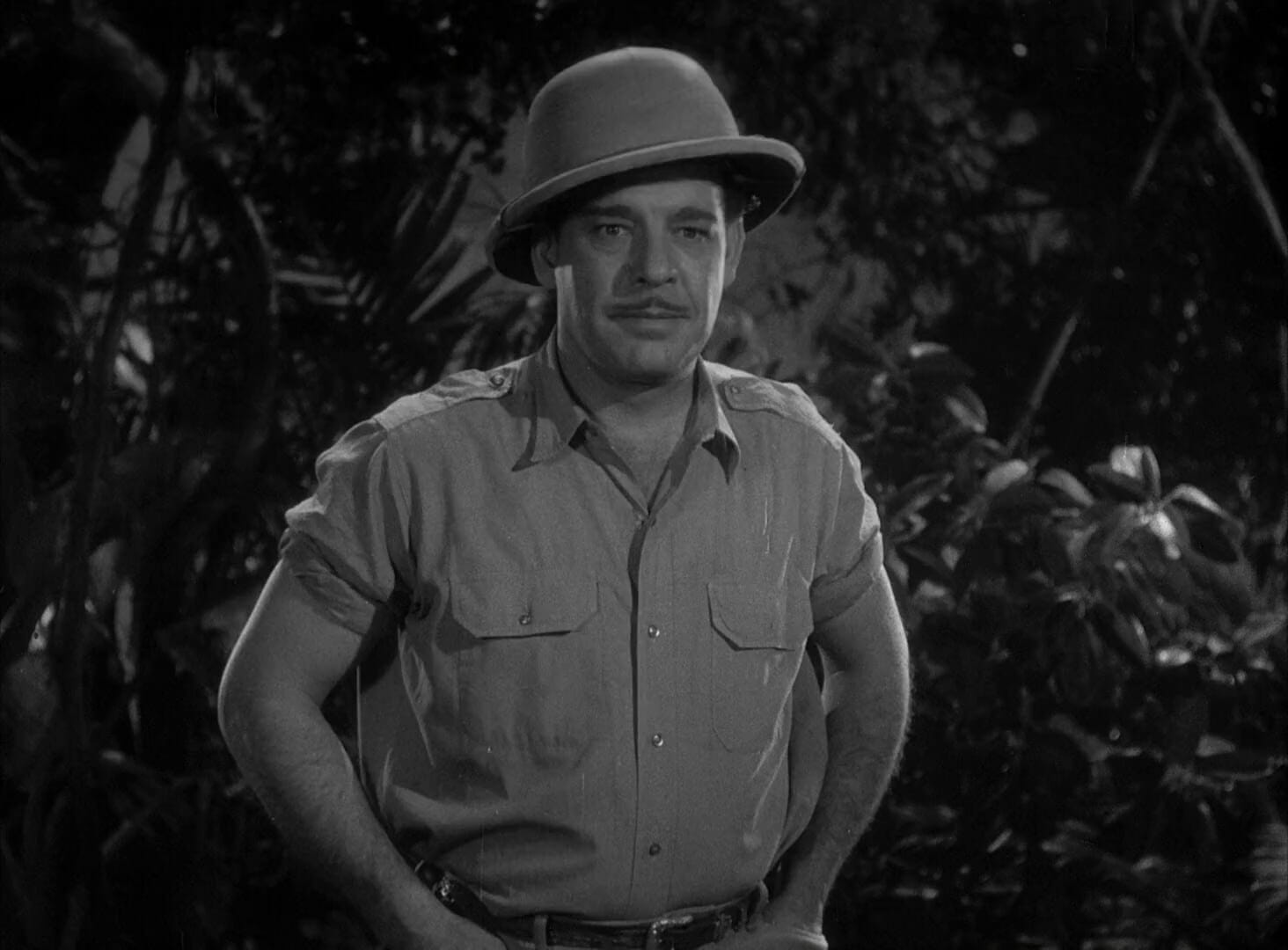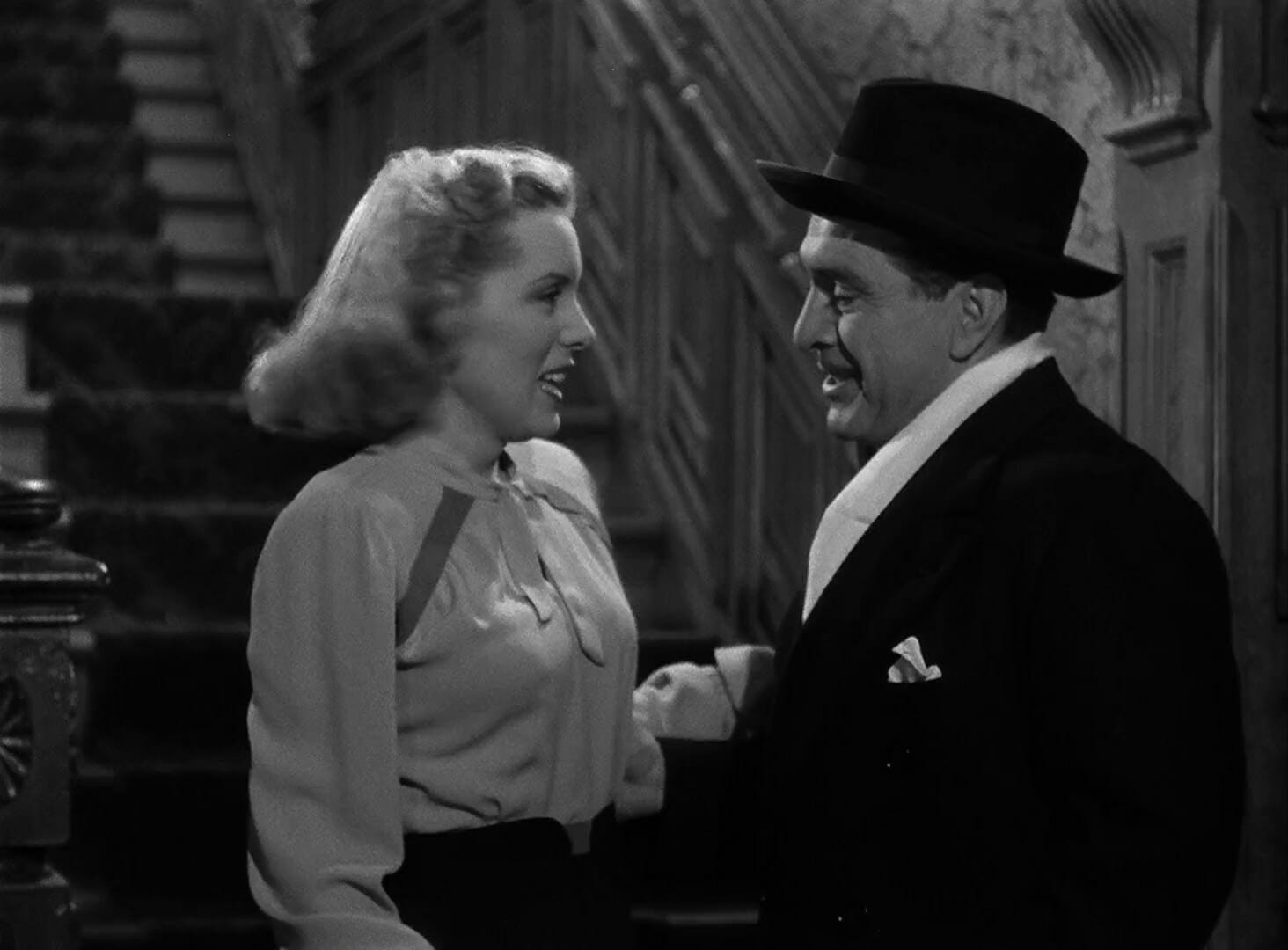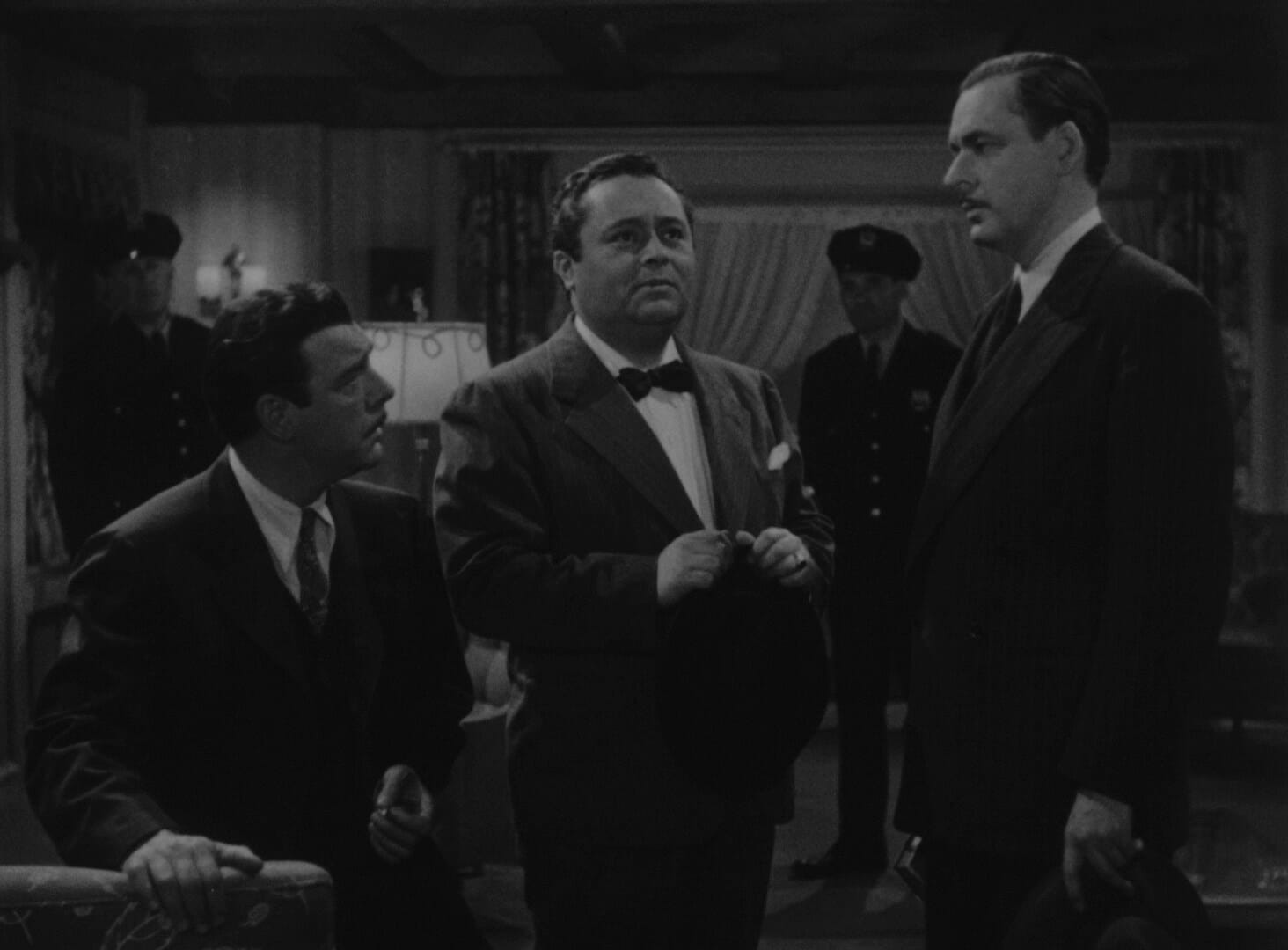It’s more or less a forgotten obscurity today, but the Inner Sanctum was one of the first true multimedia franchises of the 20th century, spanning a publishing imprint, a popular radio anthology series, and a series of feature films starring the great Lon Chaney, Jr. The publishing line’s bread and butter was its mystery novels, while the radio series popularized the kind of pun-heavy, tongue-in-cheek “horror host” (embodied by the droll Raymond) that would go on to inspire the famous EC Comics Cryptkeeper and every local TV weekend creature feature host from Dr. Paul Bearer to Svengoolie. The film series, prohibited by some complex tangle of rights issues (another hallmark of the modern-day multimedia intellectual property franchise), didn’t include Raymond or the radio show’s famous “creaking door,” instead opening each story with an introduction by a mysterious, disembodied head floating in a crystal ball, helpfully informing viewers that “this … is the Inner Sanctum.”
Each Inner Sanctum film stars Lon Chaney, Jr. in a different role, usually plagued by some form of torturous guilt or another. Taken separately, each movie is a fun little chiller, only about an hour long, the kind of thing that used to keep late night TV in business but is now relegated to historical archives and specialty Blu-ray sets. But if you watch them all together, they begin to form an off-kilter portrait of men, all of whom look and sound like Lon Chaney Jr., being hounded and terrorized by a series of implacable authority figures, ghosts, and femme fatales.
The first Inner Sanctum film, Calling Dr. Death, establishes the tone and motifs of the series right off. We have Lon as a neurologist who specializes in treating patients by way of hypnosis, the plot driven by his own whispered inner monologue as he begins to suspect that he murdered his unfaithful wife during an amnesiac blackout. He is antagonized by a police detective played by J. Carroll Naish (who returns for a later film in the series), who acts as a kind of nightmare Columbo figure or one of Patricia Highsmith’s unshakable detectives, whose job seems to be less about solving a crime and more about serving as an external manifestation of a specific person’s guilt and anxiety. Naish is, naturally, fantastic in such a role, and it’s a shame that no one thought to cast him in each of the Inner Sanctum films opposite Chaney in a kind of eternal duel between detective and suspect.
Calling Dr. Death was followed up by Weird Woman, the first of several screen adaptations of Fritz Leiber’s excellent supernatural thriller Conjure Wife to be made over the years. Chaney fills the role of the academic who suspects his wife may be involved in witchcraft, but unfortunately Leiber’s clever hook about a massive secret occult society of women is replaced by a vague (and somewhat racist) plot about generic South Seas “voodoo.” Still, Weird Woman is another fun Inner Sanctum outing with some authentic 1940s Exotica atmosphere, and of course another good performance from Chaney.
Dead Man’s Eyes is Inner Sanctum Mystery number three, and its title gives you the first clue as to what it’s about. This is a very clear entry in the subgenre I call “eyeball horror,” familiar to anyone who’s read a lot of 1950s horror comics, the plot involving Lon’s possibly intentional blinding by way of an acid eyewash. The turns of the plot are overshadowed, however, by the film’s final image: a triumphant zoom-in on a strange hat worn by actress Jean Parker that from the right angle looks like, that’s right, an eyeball. Genre queen Acquanetta also stars, as yet another woman hopelessly in love with Lon Chaney, Jr.
If your interest in the Inner Sanctum is driven by a love of old-fashioned Halloween spookiness, The Frozen Ghost will likely be a clear highlight of the series. Here we have stage mentalist Gregor the Great (Chaney) who becomes ridden with guilt after a drunk man dies during one of his performances. He believes that the man was killed by way of his own mental energy, which makes him all the more susceptible to what may or may not be a complex gaslighting scheme to drive him insane and divest him of his family fortune. There’s a wax museum, a disgraced plastic surgeon with a penchant for knife throwing, and one very scary looking furnace, although whether or not there is a frozen ghost is a debatable point — the title seems to be a reference to the mesmerized living dead that are exhibited in the wax museum for reasons too complicated to go into here.
On the other end of the spooky spectrum is Strange Confession, a remake of an earlier film (with a much better title: The Man Who Reclaimed His Head) and a clear outlier of the Inner Sanctum series. Here we have virtually no mystery or horror elements whatsoever, save for a brief bit of mind control mumbo jumbo on the part of the film’s villain (J. Carroll Naish again) and a terrific framing device involving Chaney in an impromptu legal consultation with a mysterious black medical bag in tow. I won’t spoil the contents of that bag (although the title of the film’s source material gives you a clue), but the story that brings us to Strange Confession’s gruesome conclusion isn’t much of a horror movie at all. Instead, this is a mature, engaging drama about a chemist who puts his own career advancement aside for the greater good of humanity, and in so doing trusts the wrong sleazy executive one too many times, resulting in tragedy and grisly revenge. I would never recommend only seeing one of the Inner Sanctum films, especially if you’re interested enough in the series sight unseen to have read this far, but if you did you’d probably want to make it this one.
It may have been impossible to follow up Strange Confession with anything but a disappointment, and sure enough Pillow of Death is something of a low note to end the Inner Sanctum series on. A convoluted murder mystery involving an attorney (Chaney again) accused of murder by departed spirits and a possibly phony (or possibly authentic) spirit medium played by the great J. Edward Bromberg with an overflow of tongue-in-cheek sleazy charm, Pillow of Death skates by on a minimum baseline of entertainment value with some fun spooky seance and cemetery atmosphere (and some very funny comic relief), but can’t help but feel a little watered down compared to other entries in the series. You can only go so far with a title like Pillow of Death, it seems.
Any fan of mid-century pulp mystery thrillers should know about the Inner Sanctum, both in its radio and cinematic forms. The films are also a grand showcase for the acting talents of Lon Chaney, Jr., who was unfortunately often relegated to mute henchmen and monsters later in his horror career, but here gets to play a variety of handsome, charming leading men, so handsome and charming that he usually finds himself extricated in one variety of love triangle or another throughout the series. They’re also a great source of that particular Universal horror atmosphere, even though they’re short on the monsters that the studio specialized in, more interested in mystery plots and Scooby-Doo-style supernatural fakeouts than genuine horror. But sometimes, that’s enough.
